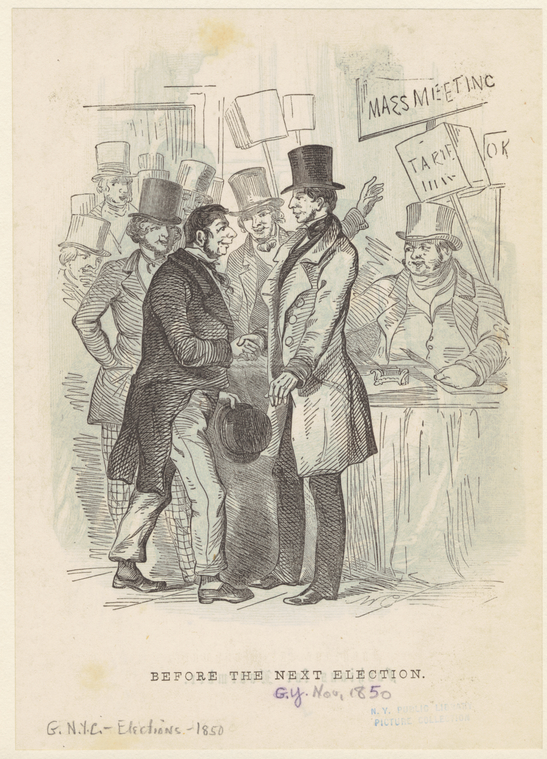Election Cake
Those who know me well may think I'm stuck on confections in general, but with the presidential election less than two weeks away, I cannot think of a more appropriate juncture to discuss the inauguration of election cake into American culture. And what would such an examination be without sharing a few traditional recipes found in NYPL's collection!
The birthplace of election cake can be traced back to the gubernatorial elections held in Hartford, Connecticut as early as 1660 when English colonies, Connecticut and Rhode Island, were granted the right to elect their own governors—long before the Revolutionary War began in 1775. Some primary evidence of the cake's existence is found at the Connecticut Historical Society, which holds the Colonial Records of Connecticut. These papers show that in May 1771, a man named Ezekial Williams submitted a bill to the Connecticut General Assembly to be reimbursed for the cost of making election cake for the colonial capital’s public festivities (also known as “Election Day Drinkings”). Historians have come to believe that election cake was adapted from yeast breads of that period popular in England.
The first appearance of an election cake recipe in a cookbook is in Amelia Simmons' second edition of American Cookery (Albany, 1796). Simmons' publication was the first of its kind to be written by an American for the American marketplace; prior to this, only British cookbooks were printed and used in the colonies. And while the number of servings Simmons' election cake recipe yields is not indicated, thirty quarts flour, 10 pound butter, 14 pound sugar, 12 pound raisins, 3 doz. eggs... certainly sounds like it could feed a crowd—and essentially it did, given the nature of the election day celebrations that were open to any resident who wanted to partake. (View the entire digitized version of Simmons' 1798 edition of American Cookery available through Feeding America: The Historic American Cookbook Project) It is not surprising, given this large quantity of ingredients, that colonial women slaved for days prior to election day baking upwards of a dozen "loaves" or cakes to accommodate guests visiting from other Connecticut towns for the celebration. The competitive spirit was in the air, as women vied to win for "top cake" among their neighbors and friends.
Many of the recipes I located in 19th century publications refer to the sweet specifically as Hartford Election Cake. One such cookbook in the Research Libraries' collection is Hartford election cake and other receipts: chiefly from manuscript sources (Hartford, 1889). It contains 11 recipes for election cake each giving credit to the recipe contributor. (View the full digitized version of this cookbook offered through Google Books.)
American poet, Lucy Larcom, near the end of her life, reflected on growing up in Massachusetts during the 1820s in A New England Girlhood (Boston, 1889) and reminisced about the vanished tradition of election cake. She writes, ‘Old Election,” “’Lection Day” we called it, a lost holiday now…and it came at our most delightful season, the last of May. My mother always made “’Lection” cake” for us on that day. It was nothing but a kind of sweetened bread with a shine of egg-and-molasses on top; but we thought it delicious. (View the entire digitized copy of this book through Google Books.)
One hundred years after Amelia Simmons' cookbook was first published, an election cake recipe was included in the first edition of Fannie Farmer's The Boston Cooking-School Cook Book, (Boston, 1896)—it's a much simpler version of earlier recipes and one you might feel enticed to bake as November 4 approaches!
Election Cake (Boston Cooking-School Cook Book, 1911)
1/2 cup butter
8 finely chopped figs
1 cup bread dough
1 1/4 cups flour
1 egg
1/2 teaspoon soda
1 cup brown sugar
1/2 cup sour milk
2/3 cup raisins seeded, cut into pieces
1 teaspoon cinnamon
1/4 teaspoon clove
1/4 teaspoon mace
1/4 teaspoon nutmeg
1 teaspoon salt
Work butter into dough, using the hand. Add egg well beaten, sugar, milk, fruit dredged with two tablespoons flour, and flour mixed and sifted with remaining ingredients. Put into a well-buttered bread pan, cover, and let rise one and one-fourth hours. Bake one hour in a slow oven. Cover with Boiled Milk Frosting.
(See the full digitized version of The Boston Cooking-School Cook Book via Google Books.)
Read E-Books with SimplyE
 With your library card, it's easier than ever to choose from more than 300,000 e-books on SimplyE, The New York Public Library's free e-reader app. Gain access to digital resources for all ages, including e-books, audiobooks, databases, and more.
With your library card, it's easier than ever to choose from more than 300,000 e-books on SimplyE, The New York Public Library's free e-reader app. Gain access to digital resources for all ages, including e-books, audiobooks, databases, and more.
If you don’t have an NYPL library card, New York State residents can apply for a digital card online or through SimplyE (available on the App Store or Google Play).
Need more help? Read our guide to using SimplyE.

Comments
Sour milk?
Submitted by Sachiko Clayton on October 21, 2008 - 9:51am
Yes, buttermilk is the
Submitted by Gina Halkias-Seugling on October 21, 2008 - 11:08am
Election Cake Recipe
Submitted by Liz (not verified) on October 28, 2008 - 10:06pm
Recipe for election cake
Submitted by Hilarity (not verified) on November 4, 2008 - 3:30pm
Election cake recipe
Submitted by P J Evans (not verified) on November 5, 2008 - 6:10pm
Election Cake Recipe - answer
Submitted by Bonnie (not verified) on November 6, 2008 - 8:11pm